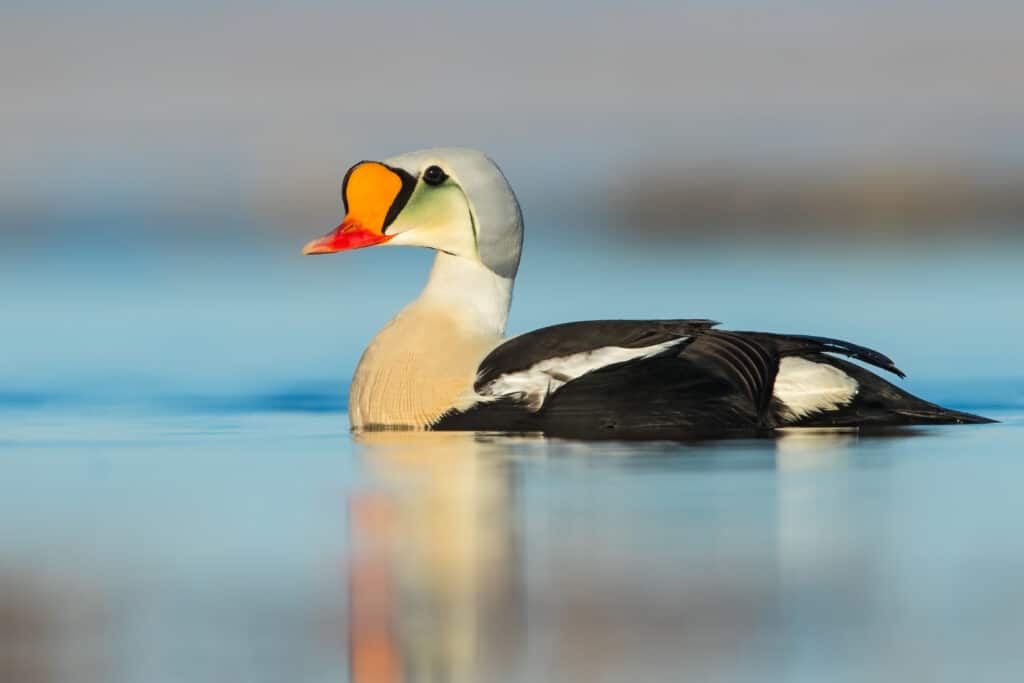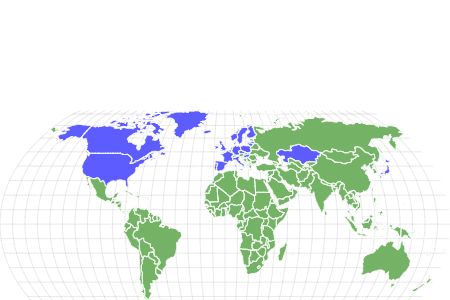King Eider
Somateria spectabilis
The species name, spectabilis, is Latin for “showy” or “remarkable,” referencing the attractiveness of the adult male’s plumage.
Advertisement
King Eider Scientific Classification
- Kingdom
- Animalia
- Phylum
- Chordata
- Class
- Aves
- Order
- Anseriformes
- Family
- Anatidae
- Genus
- Somateria
- Scientific Name
- Somateria spectabilis
Read our Complete Guide to Classification of Animals.
King Eider Conservation Status
King Eider Facts
- Prey
- Mollusks, insects, sea urchins, starfish, algae
- Main Prey
- Mollusks
- Name Of Young
- Ducklings
- Group Behavior
- Social
- Fun Fact
- The species name, spectabilis, is Latin for “showy” or “remarkable,” referencing the attractiveness of the adult male’s plumage.
- Estimated Population Size
- 800,000 to 900,000
- Biggest Threat
- Hunting, oil spills, habitat shifting
- Most Distinctive Feature
- Bulging orange forehead
- Distinctive Feature
- Short, thick necks and heavy bills
- Wingspan
- 34 to 40 inches
- Incubation Period
- 22 to 24 days
- Age Of Fledgling
- Shortly after hatching
- Habitat
- Arctic tundra
- Predators
- Arctic foxes, minks, ravens, gulls, skuas
- Diet
- Omnivore
- Lifestyle
- Diurnal
- Type
- Bird
- Common Name
- King eider
- Location
- North America, Europe, Asia
- Nesting Location
- Depression in raised ground near water
- Migratory
- 1
View all of the King Eider images!
The king eider (Somateria spectabilis) is a large sea duck inhabiting Arctic tundra habitats over three continents. These ducks are highly social and vocal birds who spend their days diving underwater for mollusks and other marine creatures. Due to their preferred environment, this species faces several threats, including oil spills and shifting habitats. Find out everything there is to know about the king eider, including where it lives, what it eats, and how it behaves.
5 Amazing King Eider Facts
- King eider males have large plates above their bills, which create a bulge in their forehead.
- They can fly up to 40 mph!
- They give dove-like calls when courting.
- These ducks eat invasive animals like zebra mussels in the Great Lakes.
- They forage for food in large flocks, all diving underwater simultaneously.
Where to Find the King Eider
King eiders live in North America, Europe, and Asia in over 25 countries, including Canada, Greenland, Russia, Norway, and the United States. They breed in Arctic tundra habitats in Canada, Alaska, Greenland, and Russia and winter in Sub-Arctic marine areas near the Bering Sea, Norway, Scotland, and Eastern Canada. In the United States, you can find them in winter along the Northeastern coast, as far north as Maine and as south as Virginia.
King Eider Nest
Their nesting site is on raised, dry ground near a water source. The nest itself consists of a shallow depression in the earth, which females line with down and plant material.
Scientific Name
The king eider (Somateria spectabilis) belongs to the Anseriformes orders in the Anatidae family, which includes ducks, geese, and swans. The Somateria genus encompasses the eiders, large sea ducks that breed in colder regions of the northern hemisphere. The genus name is Greek for “wooly body” and refers to its famous thick, soft down. The specific name, spectabilis, is Latin for “showy” or “remarkable,” referencing the attractiveness of the adult male’s plumage. The king eider is monotypic, meaning there are no recognized subspecies.
Size, Appearance, & Behavior

Measuring between 20 and 28 inches, with a 34- to 40-inch wingspan, the king eider is a large duck.
©Agami Photo Agency/Shutterstock.com
The king eider is a large sea duck, measuring 20 to 28 inches and weighing 3.4 to 3.6 pounds, with a 34- to 40-inch wingspan. They have stocky builds with short, thick necks and short, heavy bills. Males have a large plate above their bill, creating a bulge in their forehead. Females have a slight slope. Adult males have a light bluish-grey head, pale green cheeks, primarily black bodies, orange forehead plates outlined in black, and red bills. Females are rusty brown with intricate black patterns and black bills. Juvenile males are dark brown with white chests and orange bills.
This species is highly social, breeding with multiple partners and traveling and foraging with large flocks. However, breeding males are more solitary as they defend their nesting areas. Like other ducks, king eiders are relatively vocal birds. Their alarm calls sound like low quacks, and they give dove-like calls when courting. Their other vocalizations include grunting, croaking, growling, and murmuring. These birds are strong fliers, reaching speeds up to 40 mph!
Migration Pattern and Timing
King eiders are short to medium-distance migrants. They breed on the Arctic coast of Alaska, Canada, Greenland, and Russia. And they spend their winters in sub-arctic marine areas like the Bering Sea, Scotland, Norway, Eastern Canada, and the Northeastern United States.
Diet
King eiders are omnivores who eat marine animals and aquatic plants, spending much of their time diving for food at sea.
What Does the King Eider Eat?
Their diet changes seasonally, but they primarily eat mollusks. They also consume crustaceans, insects, sea urchins, starfish, algae, sea snails, mussels, scallops, clams, spider crabs, and many other species. King eiders also eat invasive species like zebra mussels in the Great Lakes. They forage for food at sea by diving underwater, more than 150 feet below the surface. They may feed alone or in large flocks, all diving simultaneously.
Predators, Threats, and Conservation Status
The IUCN lists the king eider as LC or “least concern.” Due to its extensive range and substantial population, this species does not meet the “threatened” status thresholds. However, they still face several hazards. Their biggest threats include hunting, oil spills, and habitat shifting from climate change. Most waterfowl mortality occurs within the first two weeks of life when their young are susceptible to weather conditions, predation, and food availability.
What Eats the King Eider?
King eider predators include Arctic foxes, minks, ravens, gulls, and skuas. Female king eiders use their mottled brown coloring to blend in with their environments and camouflage their eggs. Males and females may also perform threat displays toward their species or other birds.
Reproduction, Young, and Molting
King eiders form seasonal pair bonds before the spring migration to the breeding grounds. Their courtship displays include soft calls, preening, wing flapping, and posturing. Males may mate with multiple females. Females lay an average of four to five olive-colored eggs and incubate them alone for 22 to 24 days. The young fledge the nest shortly after hatching, but their mother tends to them, along with other females and their broods. King eiders become sexually mature around two to three years and live an average of nine years. However, they can live up to 24 years.
Population
The global king eider population is estimated to number 800,000 to 900,000 mature individuals. Their overall population trend is decreasing, but not at a rapid enough rate to threaten their species. North America has seen a slight, insignificant increase in its numbers over the last 40 years.
Related Animals…
View all 77 animals that start with KKing Eider FAQs (Frequently Asked Questions)
Are king eiders rare?
They have a significant population size, but due to their Arctic habitats, it is rare to spot a king eider depending on where you live. Look for them in the Northeastern United States during winter.
Where are king eiders found?
They breed in Arctic tundra habitats in Canada, Alaska, Greenland, and Russia and winter in Sub-Arctic marine areas near the Bering Sea, Norway, Scotland, and Eastern Canada.
How fast do king eiders fly?
They can fly up to 40 mph!
Are king eiders a type of duck?
The king eider is a large sea duck from the same family as ducks, geese, and swans.
What do king eiders eat?
Their diet changes seasonally, but they primarily eat mollusks. They also consume crustaceans, insects, sea urchins, starfish, algae, sea snails, mussels, scallops, clams, spider crabs, and many other species.
What threatens the king eider?
Their biggest threats include hunting, oil spills, and habitat shifting from climate change.
What are king eiders' predators?
King eider predators include Arctic foxes, minks, ravens, gulls, and skuas.
Thank you for reading! Have some feedback for us? Contact the AZ Animals editorial team.
Sources
- IUCN Red List, Available here: https://www.iucnredlist.org/species/22680409/132526730
- Oppel, Steffen; Powell, Abby N.; Dickson, D. Lynne, Available here: https://academic.oup.com/condor/article/110/2/296/5152380
- Anderson, Vanessa R.; Alisauskas, Ray T., Available here: https://academic.oup.com/condor/article/103/1/195/5563257

















